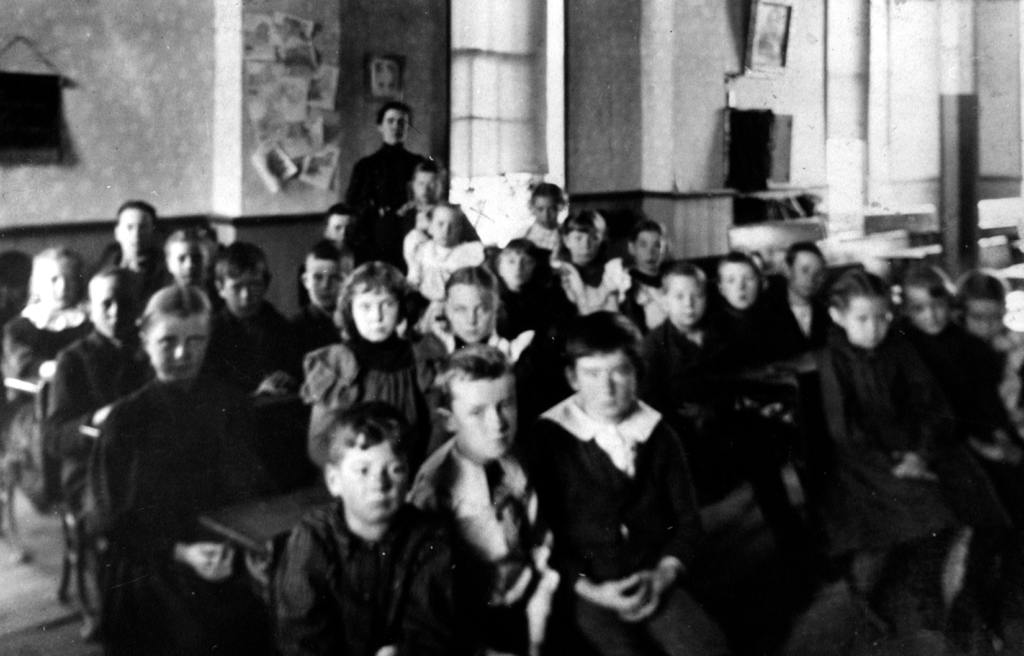
SRHS
Steamboat Rock Historical Society
A NEW CENTURY
SCHOOL STILL IN ONE ROOM
The style of the day was a one room country schoolhouse. The teachers day started very early in the morning. The teacher started a fire in the stove with cobs and coal from the shed that was usually kept supplied by nearby farmers. While the building was warming up, the teacher swept the floor, checked papers, and prepared lessons for the day.
In the days of the country school children might have to walk a mile or more to attend. This was not thought to be difficult since nearly everyone did it. If the weather was really bad the father might take the children to school in the bobsled. Straw was put in the bottom of the sled and the children would sit in a row on the straw. If it was very cold, a blanket was often put over their heads, like a tent. Sometimes rocks or bricks were heated on the stove and taken along to help keep feet warm.
When the children arrived, two students were usually chosen to go to the nearest farm and get a pail of water for the children to drink and to prepare lunches.
All of the students drank from a dipper that everyone used. Later a crock with a spigot was furnished and students were each given a cup of their own.
Other students cleaned the blackboards and dusted the erasers.
The dinner buckets were many and varied: syrup pails, Home Comfort and Summertime tobacco pails and some brightly painted lunch baskets. For the noon meal students brought in jars of food and heated in a pan of water on the heating stove. The pupils would bring cocoa, peas corn, stew and whatever they wanted. It probably tasted good on a cold day. Other items in the lunch pail might be bread and butter with plum or apple butter. Some children might find a cookie or piece of cake. Others might have an apple.
The teacher taught grades 1 through 8. There was no kindergarten until consolidation. Language, arithmetic, spelling, history, reading, geography, and penmanship were taught. Sometimes art and music were included.
Farming being the major industry in the area meant that many of the boys had to take time off in the fall to help pick corn, and again in the spring for planting. Some only went in the winter months. Most of the desks had double seats that were shared with another person. Books were limited, and often the lessons were written on the blackboard and copied by the students. Students graduated when they reached 16, or made the grades they needed. If they made their grades they were qualified to teach. Many did for a year or two.

Mrs. Warrington’s intermediate room, grades 3,4,and 5, September 1898. Students seated two to a desk just as in the country schools. Back Row: Effie Moore, John Kiger, Ethel Dogherty, ? Carsens, Clarence Fisk, Nora Hutzel, Alta Cable. Third Row: Ben Niessen, Ralph Wickham, Boyd Cartwright, Ruby Noyes, Meta Kelso, Jessie Evens. Second Row: Sophia Potgeter, Frieda Eilers, Georgia Morse, Harry Reynolds, Tom Eilers, Harry Platts. Front Row: Edward Ruppelt, Dale Jackson, Ernest Wickham, Winnie Perkins, Joy Hemp, Jennie Luiken.
Teachers of that day were always single, once they married they were not allowed to teach school.
The restrooms were outside in a small building called an outhouse.
Those who attended remember noisy slates, sour smelling slate rags. The teacher that made you stand in the corner. A note written to a friend or pinned on someone’s back for someone else to read. Trading lunches, a spanking in front of the class, getting the giggles, halls filled with coats and overshoes, and many more memories.
Before the consolidation of schools the country school was a community unto itself. It was the center of all neighborhood gatherings. Picnics, box socials, and other activities were quite popular. Spelling bees, recitations, and other student activities were well attended.
When the older children, and older often meant ten or older, got home from school they all had chores to do. Feed and water the chickens and sometimes gather the eggs. Ashes had to be carried out from the cook stove and heater, and wood, cobs, and coal had to be carried in. Water was carried in for drinking, cooking and to fill the reservoir on the cook stove. By that time it would be supper time. After supper some had to help with the milking, and the girls did the dishes. The rest of the evening was spent playing cards like Rummy, Flinch, Hearts, and Old Maid. Carom and checkers were also popular. All were done by the light of a lamp or lantern.
The mother would sit and sew quilt blocks, embroidery, crochet, or mend clothes. In the daytime she would sew dresses for herself and daughters. In wintertime they would take quilts apart, wash the covers, and tie them back together.
In the summer wood and cobs had to be carried to the woodshed for the winter. Loads of corn were shelled one ear at a time in a hand cranked sheller. Later they were motorized with a gas engine. The cobs were saved and additional cobs were picked up from the pig pen and horse stalls. Cobs were used in the cook stove in summer because they made a quick fire and didn’t heat up the house as much as wood. In winter they were helpful in starting fires. Wood was cut and stacked and the older drier wood was put into the shed to keep it that way.
© 2020 Steamboat Rock Historical Society | All Rights Reserved
Powered by Hawth Productions, LLC